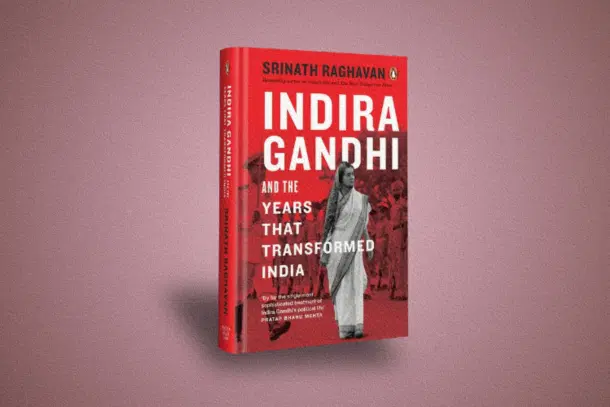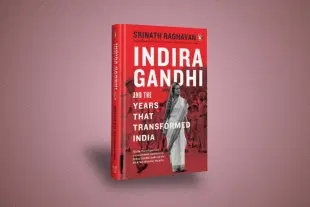Books
Indira Gandhi, Resurrected
Prem Ansh Sinha
Jul 19, 2025, 01:50 PM | Updated 01:50 PM IST
Save & read from anywhere!
Bookmark stories for easy access on any device or the Swarajya app.


Indira Gandhi and the Years that Transformed India. Srinath Raghavan. Penguin Allen Lane. Pages: 367. Price: INR 899.
In an essay titled Rashtrapati published in the Modern Review (Calcutta), Pandit Jawaharlal Nehru, under the pseudonym Chanakya, meditates on his destiny. It was around a decade before he became the first premier of the Republic, two years until the disastrous resignation of the Indian National Congress (INC) ministries, and almost a year before Chamberlain imprudently conceded the Sudetenland to Hitler, making the Great War inevitable.
Nehru finds himself conflicted and writes, “He (Nehru) must imagine that he is indispensable, and no man must be allowed to think so. India cannot afford to have him as president of the Congress for a third year in succession.” Being aware of the perils of democracy, he worries that “...a little twist and Jawaharlal might turn a dictator, sweeping aside the paraphernalia of a slow-moving democracy.” It was perhaps an assurance to the readers about his democratic credentials, and a self-examination, too, that he found ad rem for the upcoming presidents of the Congress.
Indira Gandhi and the Years that Transformed India studies the circumstantial undoing of Pandit Nehru's political legacy by his daughter, who was supposedly, as was often iterated, the sole claimant of the Nehruvian principles. The book examines a paradoxical struggle for power that oscillates between Machiavellian realpolitik and Gandhian ‘holier than thou’ ideals. Contrary to what Prof Pratap Bhanu Mehta may say, the book does not come across as “the single most sophisticated treatment of Indira Gandhi's political life”; neither is it a bad attempt at tracing the history of her times. Parting ways from binary blanket conclusions, similar to Indira Gandhi's political map, the book deserves a nuanced attempt at review, too.
Indira Gandhi Comes Alive
Prof Raghavan writes (p. 2), “India had fought two wars and faced two consecutive years of harsh drought—all of which had thrown the economy off-kilter... the old political order constructed by her father's generation was visibly crumbling.” The prologue sets the stage by encapsulating the tensions that had been building since the 1962 debacle under the shadow of the failure of the five-year plans. It pushes the readers to think if things would have been better had the Congress Party listened to Mohandas K. Gandhi's advice to (p. 6) “liquidate itself as a political entity and work for social transformation.” And in this tumultuous period, much to her initial reluctance, Indira Gandhi emerges as Kamaraj's Lucius Cincinnatus to the Congress Party; but unlike Cincinnatus, she does not voluntarily reject power later, turning out to have Caesarist attributes.
Indira Gandhi's domestic concerns about food and the economy in 1966 were intertwined with external challenges. On the brink of starvation, India was pushed by the United States to give up cooperative agriculture to adopt technology-intensive methods. The latter, known as the Green Revolution, which gained traction during Lal Bahadur Shastri's last days as the premier, was made a key priority in Gandhi's objectives. This shift helped address immediate concerns but also widened the gap between rich and poor farmers, further exacerbating regional agricultural disparities, too. Speaking of which, the author also touches upon the rollback of the wheat nationalisation policy of 1972, which he subtly presses as another policy failure that happened due to Indira Gandhi's overreliance on her satraps, in this case, the then Union Minister of Planning, D. P. Dhar, who was later sent back for an ambassadorial posting in the Soviet Union again. There is a serious cluelessness in the policies undertaken by the Planning Commission. Bureaucrats seem more worried about saving the Prime Minister's political face than advising on what might go right for the country. There are exceptions to the tomfoolery in the Prime Minister's Secretariat, but they are either dismissed or, like B. S. Minhas, left with no other option than quitting.
In the 1960s and the events leading to the Emergency, Indira Gandhi is in a perpetual state of mayhem with an insatiable desire to establish herself as the pillar of stability; primarily because while she was deemed a legitimate successor of Pandit Nehru's legacy, her political inexperience was thought to be a factor that could help the syndicate strongly influence her decisions. But much to the chagrin of the old guards of the Congress, Indira preferred and carried a tendency to personalise politics. As the former Congress Party president D. K. Barooah said, "India is Indira, Indira is India," she imagined her political leadership to be indispensable. Prof Raghavan notes, “she sought at once to establish a direct connection with the populace... and in doing so, she crafted a distinctive, Caesarist politics.”
In the chapter titled ‘War and Peace,’ Prof Raghavan examines the 1971 War that led to the liberation of East Pakistan, a conclusive defeat of Pakistan, and the formation of Bangladesh. This was the moment when Indira Gandhi cemented her reputation in the pages of history. Much to the disappointment of a reader, the chapter is only a cursory read of the circumstances. Being aware of the author's background and expertise on the subject of war, in this case, one need not tread down the path of overexpectation. This seems to be one of the only few chapters that indirectly refers to Indira Gandhi's foreign policy, which is another significant political component missing in the book. In those references, we come across the most distinguishing feature of Indian foreign policy—isolation. India was asked to act with restraint by the international community, including the Soviet Union. This, in no way, should be taken as a criticism of the policy, given the structure and objective of the foreign office of India. The very idea of a foreign policy in the interest of a country often leads to such an aloofness with circumstantial allies. But this does not justify her hollow treatment of the Shimla Conference.
With 93,000 prisoners of war from Pakistan, including other factors, India had an upper hand in the subsequent peace agreement. Prof Srinath Raghavan notes (p. 84), “The postwar conference in Shimla showed her capable of managing the peace as well as winning the war.” He further mentions how P. N. Haksar persuaded her “not to impose a punitive peace on Pakistan,” by citing how the Treaty of Versailles had sown the seeds of the Second World War. Even if one removes a retrospective lens to analyse the situation, it comes across as a very flawed justification, which would subsequently haunt the Prime Minister's Secretariat in the years to come.
In 1974, B. K. Nehru, Indira's cousin and a sharp diplomat, urged (p. 194) her to replace Garibi Hatao (remove poverty) with Utpadan Badhao (increase production). He tried elaborating his rationale by saying, “Does ‘social justice’ mean equality in poverty—or growth in the size of the national cake, which may continue to be divided in unequal portions—if necessary?” Despite her annoyance, she asked him to elaborate further. Prof Raghavan notes (p. 194) that she “would neither go so far nor so fast, yet... she did avow the intent to move towards relaxing the government's hold on the private sector during the Emergency period.” This would later pave the way for a smooth liberalisation of the economy in the 1990s.
The author writes of the nationalisation of banks, devaluation of the rupee, and the abolition of privy purses. These decisions pushed all the opposing factions to come together as a single entity against Indira Gandhi. While one may call the policies the effect of a left-leaning faction being led by the premier after the split of Congress, the excess interference of the executive in the judiciary was where the civil society and the press turned against her as well. Sycophancy became the chief guarantor to gain satrapy in the judiciary. While the twenty-point programme of Congress might justify the Emergency, J. P. Narayan in 1973 rightly noted a “precipitous fall in moral standards of our public life... that nothing seemed to outrage our conscience or stir us to action.” What may be interesting to historians and readers is how, despite everything, Indira Gandhi does not concede the moral high ground. She writes to Yehudi Menuhin (p. 182), “Democracy is not an end. It is merely a system by which one proceeds towards the goal. Hence, democracy cannot be more important than the progress, unity, or survival of the nation.”
No More Caesars?
Prof Raghavan's book turns out to be a fantastic account of the events leading to the Emergency, the well-crafted exchange of missives, the struggle in the Congress Party—all narrated coherently, which glues the readers throughout those pages, but there are parts that seem rushed. Foreign policy remains a crucial aspect of any political leader, which is scattered throughout the book with references that are restricted to the United States and the Soviet Union, in some cases. As mentioned before, there is only a cursory read available for the 1971 War, the Shimla Conference, and the book ends very abruptly with Indira Gandhi’s assassination post Operation Blue Star. Sources seem limited to the accounts by her satraps and popular information. Looking at the coherence and structure, had those aspects been incorporated, the book could have been the most authoritative account of Indira Gandhi's life. While I may be harsh in judging a public historiography on the depth of its research, it must be reiterated that the readers are encouraged to read it.
With three prime ministers having had Caesarist attributes so far, it may push one to contemplate: Does the Indian republic yearn for a democratically elected Caesar?





